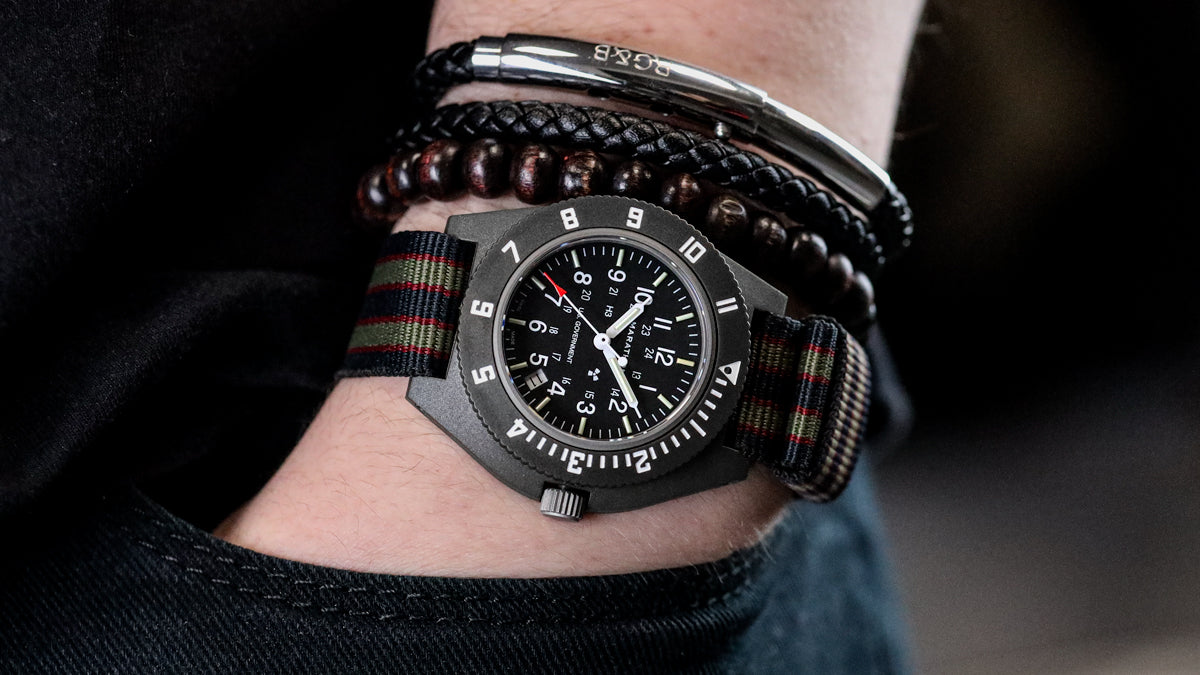Confused about water resistance ratings? Don't worry, you're not alone. Let us guide you through the minefield and bust those myths!
There is something satisfying about snorkelling in clear azure water and looking at your watch through a diving mask, ticking away resisting the elements. Almost all my water-resistant watches have been underwater, even if it’s just a swimming pool, and the few I own guaranteed to be waterproof, have all been in the oceans.

The NTH Näcken V2, an example of a very capable 300m dive watch - Image Credit: WatchGecko Online Magazine
This is a feature about water resistance ratings and what they mean in the real world. It will aim to debunk myths, clarify conflicting data, and offer helpful suggestions.
In the interests of full disclosure, I confess to speaking from bitter experience. As a teen I embarked on my first snorkelling adventure in the Indian Ocean wearing a “waterproof” digital watch. With my arm barely submerged I was supremely confident as my watch stated it could resist water to 30m or 98.4ft. After conquering the ocean, you can imagine my disappointment to see the watch steam up, form moisture inside the glass, and slowly die.
I simply did not understand what 30 meters water resistance meant. Thankfully the next day I spoke to an experienced diver. The conversation was a revelation and by the end of the week I was sporting a brand new 100m stainless Casio Diver ref: AMW 320D-9EV.
These memories have been awakened by a friend recently asking me whether a 30m watch was suitable for his child to go snorkelling with on holiday. He was more than surprised when I explained that a 30m watch is not waterproof, indeed this spec will barely resist rain or light splashes.
So, what do depth ratings actually mean?
First it is important to understand how watches are labelled. Depth is traditionally measured in meters, feet (less common now) or ATM (Atmospheres). The first two are self-explanatory while ATM refers to how far beyond surface air pressure the watch will tolerate. 1ATM roughly equates to 10m water depth and the resulting pressure. If your watch says 5ATM think of it as 50m water resistant. Even at shallow depths water exerts quite a lot of pressure on the seals of a watch.
At a just 20m a watch must hold back approximately 30psi; that’s the pressure in a car tyre. As you go deeper the forces increase exponentially. At the bottom of the Challenger Deep, in the Mariana Trench, the pressure is a crushing 16,000psi. James Cameron has dived the full 11 km depth with a Rolex Deep Sea strapped to the side of his submersible. There is lots of information about this astonishing feat online; it is fascinating and well worth researching. However, back in the real world, you will see the following meter ratings on a watch.
Water Resistant
Truthfully, no resistance at all. Despite what is claimed this watch will struggle to defeat rain if you are caught in a shower. It will most likely be found on a dress watch and it should be worn in a nice restaurant and nowhere else.
Watches with a 30M water resistance rating
Possibly the most misleading term. This watch is NOT really water resistant. It certainly cannot be used for swimming. However, it should stand strong against rain and higher levels of humidity.
Watches with a 50M water resistance rating
This is the first rating to offer some rudimentary water resistance. It will be fine for splashing around in a swimming pool on holiday. Ideal for children; my son’s first watch was a classic 50M Casio W-59. A 50m watch can fail in a combination of very high humidity and heat.
NB: 30M and 50M watches should adhere to ISO 2281 which demands basic specs and the guarantee that random sample testing has taken place. But be advised that these tests take place at just 10cm depth and for a maximum of an hour so that really should reinforce how limited the capability is. There are exceptions with some 30M watches being exceptionally well made and costing upwards of £5000 (i.e., the Speedmaster) but the fact remains, they are not waterproof.
Moving on to dive watches, which start at 100m, we find watches which are both ISO 6425 certified and those which are not. Certified watches are effectively guaranteed to hold back water; non-certified means non-tested, but they will still theoretically repel the stated level of water pressure. It’s a bit confusing but if you are a professional or serious diver play safe and stick with ISO 6425. Testing to this standard is much higher involving watches submerged to 30cm for 50 hours along with additional tests to ascertain resistance to sub-surface dynamic movement, shocks, and magnetic forces.
Watches with a 100M water resistance rating
Suitable for most water activities including light snorkelling and sports where water can impact on a watch with some force. Not ideal for sustained diving but if you were experiencing a pool “try dive” on holiday you will be fine. As previously stated, tested watches should be water resistant to this depth, most notably Rolex who guarantee full waterproofing at 100M.

The YEMA Rallye Mario Andretti Chronograph features 100m water resistance - Image Credit: WatchGecko Online Magazine
Watches with a 200M water resistance rating
The first of the serious depth ratings. This capability will withstand scuba diving and is considered good enough to be a proper dive tool. Topside, it is extremely unlikely any 200M watch will let you down in high humidity, heat, cold or during any water borne activity. It’s a good mid-capability level for an everyday watch.
Watches with a 300M water resistance rating
A beefed up 200M spec which is probably the best option for a diver but believe it or not is still one step away from the “deep sea” genre. A 300M watch will resist all elements that nature can throw at you, no matter how extreme so they make excellent dive and adventure watches. There is actually very little written about the differences between 200M and 300M watches. The easiest way to understand the difference is that a 300M watch was probably designed from initial concept as a diver’s watch. A 200M may not have been.

The Marathon Automatic Diver's Watch 41mm, rated to 300m - Image Credit: WatchGecko Online Magazine
Watches with a 500M-plus water resistance rating
Suitable for saturation diving which involves a helium enriched environment. Many of these watches will come with a manual or automatic helium escape valve (as do several 300M). These are often large watches and are generally the purview of professional divers. They will often attract higher prices due to the capability and are, in truth, far beyond the requirements of most users.
There are always exceptions….
When a watch is first developed, no matter what cost bracket, the manufacturer will most likely have decided what water resistance level they were aiming for as this is fundamental to the initial design. If the specs call for an easy access battery hatch, like the one found on the Marathon Maraglo, 100m water resistance is never achievable.
The trade-off for that convenience is a water resistance of just 30M, however Marathon also use a non-standard 60M rating for their Pilot Navigator. In their defence, Marathon’s 30M rating is better than the traditional standard and their watches will certainly resist moisture to the point that you could wear one as a go-to field watch.
I once owned an IWC Aquatimer Galapagos. This claimed to be waterproof to the odd level of 120M. Again, a different designation from industry norm but given that IWC also reject COSC it is not surprising that they have developed their own depth ratings.
When a non-standard rating is given, especially from a high end manufacturer, then you can generally accept that the watch has been tested to that depth.
How can we help you find the perfect water resistant watch, whatever your requirements?
30 Meters +
Have a look at the Marathon General Purpose. We’ve just done a full review of one of these little gems which will be published soon. Suffice to say they are a pure breed military outdoor watch. The 30M rating should be adhered to but given the build quality and the fact that they fall close to US milspec you can wear these 30M field watches with confidence.
50 Meters +
There is a large selection of 50M watches from Laco which mean that you could wear them to look sophisticated and still enjoy a swim, although you may want to change the leather strap. Marathon also offer a steel version of the normally polymer General Purpose which offers enhanced capability at 50M.
However, our recommendation would be to upgrade 10M to the more capable 60M of the Marathon Pilot Navigator. These models offer exceptional environmental resistance and are almost certainly prefect to explore the planet with. They have passed US Milpec MIL-PRF-46374E 1989 which promotes a lot of confidence in the machine.
100 Meters +
Again, a wide range from Laco, Forzo, and YEMA. If you can spend close to £1000 then the Laco Bremerhaven or Ulm are hard to beat. These watches offer near prefect field characteristics due to their pilot and naval heritage dials.
We would recommend packing a good Military strap for water activities or even high humidity areas. If motorsport is your thing, then Forzo not only looks the part but also offers 100M resistance which means that you can retain your vintage Le Mans style watch and rest assured that it will not fail on a wet track day. These are due for release later this year.200 Meters +
As we begin to consider the first stage of professional underwater watches the styles change, and the specs get better. WatchGecko have an exceptional range to chose from, all offering full 200M capability and many other attributes. Squale is present with the ATMOS and YEMA with the Navygraf and Superman.
The new arrival of the Singaporean brand BOLDR has excited all of us with their hugely impressive 200M Field Watches from the Venture range. And of course, we cannot pass the innovation that is Geckota with the G-02 Gen 1 and 2.
300 Meters +
This category is really dominated by YEMA with a vast collection of 300M watches. NTH join us at this level and we can welcome Marathon back with their unique tritium Diver range. Squale offer compelling choices with their new Sub-39 collection but (for me) the only choice is the Geckota Phalanx Sierra Zero One Special Operations watch which offers specs you will struggle to find with any other model in that price bracket.
500 Meters +
In this category we have the true heavyweights and are in the realms of professional dive tools. This element of the portfolio is split evenly between BOLDR, Squale and NTH. All these machines offer the highest level of resistance and technical capabilities, such as helium valves, to deal with the complexities of deep dives.
If you want something that looks a bit different check out the stunning limited-edition bronze BOLDR watches. If supreme legibility is your governing criterion, then research the NTH Thresher which has a brilliantly designed dial.

The BOLDR Odyssey Bronze with a whopping 500m water resistance - Image Credit: WatchGecko Online Magazine











